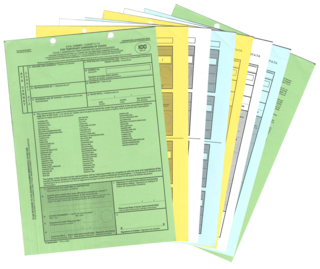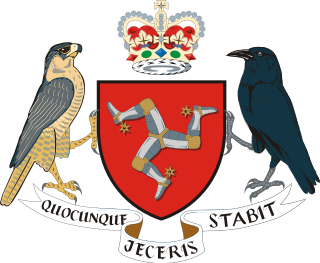Electronic data interchange (EDI) is the concept of businesses electronically communicating information that was traditionally communicated on paper, such as purchase orders, advance ship notices, and invoices. Technical standards for EDI exist to facilitate parties transacting such instruments without having to make special arrangements.

Customs is an authority or agency in a country responsible for collecting tariffs and for controlling the flow of goods, including animals, transports, personal effects, and hazardous items, into and out of a country. Traditionally, customs has been considered as the fiscal subject that charges customs duties and other taxes on import and export. In recent decades, the views on the functions of customs have considerably expanded and now covers three basic issues: taxation, security, and trade facilitation.
UN/CEFACT is the United Nations Centre for Trade Facilitation and Electronic Business. It was established as an intergovernmental body of the United Nations Economic Commission for Europe (UNECE) in 1996 and evolved from UNECE's long tradition of work in trade facilitation which began in 1957.

]
An invoice, bill or tab is a commercial document issued by a seller to a buyer relating to a sale transaction and indicating the products, quantities, and agreed-upon prices for products or services the seller had provided the buyer.

The Hong Kong Customs and Excise Department is the customs service of the Hong Kong Special Administrative Region. The agency was established to protect Hong Kong from smuggling, ensure the collection of duties on taxable goods, detect and prevent drug trafficking and abuse, safeguard intellectual property rights, protect consumer interests, facilitate legitimate business and uphold Hong Kong's trade reputation, regulate money service operators and dealers in precious metals and stones, and combat money laundering and terrorist financing.
Trade facilitation looks at how procedures and controls governing the movement of goods across national borders can be improved to reduce associated cost burdens and maximise efficiency while safeguarding legitimate regulatory objectives. Business costs may be a direct function of collecting information and submitting declarations or an indirect consequence of border checks in the form of delays and associated time penalties, forgone business opportunities and reduced competitiveness.
The single-window system or single-window concept is a trade facilitation concept which allows an international (cross-border) trader to submit information to a single agency, rather than having to deal with multiple agencies in multiple locations to obtain the necessary papers, permits, and clearances to complete their import or export processes. There is an obvious time saving benefit to the single window system. The concept is recognised by organisations such as the United Nations Economic Commission for Europe (UNECE) and its Centre for Trade Facilitation and Electronic Business (UN/CEFACT), World Customs Organization (WCO), the United Nations Network of Experts for Paperless Trade and Transport in Asia and the Pacific (UNNExT), and the Association of Southeast Asian Nations (ASEAN).

Missing trader fraud involves the non-payment of Value Added Tax (VAT) to a government by fraudsters who exploit VAT rules, most commonly the European Union VAT rules which provide that the movement of goods between member states is VAT-free. There are different variations of the fraud, but they generally involve a trader charging VAT on the sale of goods and absconding with the VAT. The term "missing trader" is used because the fraudster has gone missing with the VAT.
Custom brokers or Customs House Brokerages are working positions that may be employed by or affiliated with freight forwarders, independent businesses, or shipping lines, importers, exporters, trade authorities, and customs brokerage firms.

An importer is the receiving country in an export from the sending country. Importation and exportation are the defining financial transactions of international trade. Import is part of the International Trade which involves buying and receiving of goods or services produced in another country. The seller of such goods and services is called an exporter, while the foreign buyer is known as an importer.

A Certificate of Origin or Declaration of Origin is a document widely used in international trade transactions which attests that the product listed therein has met certain criteria to be considered as originating in a particular country. A certificate of origin / declaration of origin is generally prepared and completed by the exporter or the manufacturer, and may be subject to official certification by an authorized third party. It is often submitted to a customs authority of the importing country to justify the product's eligibility for entry and/or its entitlement to preferential treatment. Guidelines for issuance of Certificates of Origin by chambers of commerce globally are issued by the International Chamber of Commerce.

The ATA Carnet, often referred to as the "Passport for goods", is an international customs document that permits the tax-free and duty-free temporary export and import of nonperishable goods for up to one year. It consists of unified customs declaration forms which are prepared ready to use at every border crossing point. It is a globally accepted guarantee for customs duties and taxes which can replace the security deposit required by each customs authority. It can be used in multiple countries in multiple trips up to its one-year validity. The acronym ATA is a combination of French and English terms "Admission Temporaire/Temporary Admission". The ATA carnet is now the document most widely used by the business community for international operations involving temporary admission of goods.
Rules of origin are the rules to attribute a country of origin to a product in order to determine its "economic nationality". The need to establish rules of origin stems from the fact that the implementation of trade policy measures, such as tariffs, quotas, trade remedies, in various cases, depends on the country of origin of the product at hand.

The Treasury of the Isle of Man is the finance department of the Isle of Man Government. It prepares the annual budget for the Government, and also handles taxation, customs and excise, economic affairs, information systems, internal audit, currency and the census in the Isle of Man.

Sovereign Base Areas Customs and Immigration is a semi-autonomous branch of HM Revenue and Customs (HMRC) of the United Kingdom. It has jurisdiction over Akrotiri and Dhekelia, a British Overseas Territory on the island of Cyprus, administered as a Sovereign Base Area, and home to British Forces Cyprus. It is managed by the Ministry of Defence (MoD) and around 3,500 military personnel are posted there at any one time.

The Royal Malaysian Customs Department ; is a government department body under the Ministry of Finance. RMCD functions as the country's main indirect tax collector, facilitating trade and enforcing laws.

Kollam Port or Port of Quilon is one of the oldest ports situated 4 kilometres (2.5 mi) away from Downtown Kollam It is the third largest port in Kerala by volume of cargo handled and facilities and one of the four Kerala ports having immigration checkpoint (ICP) facility. Located on the south-west coast of India, it was an important port from the ninth to the seventeenth centuries. Kollam was one of the five Indian ports visited by Ibn Battuta.
A customs declaration is a form that lists the details of goods that are being imported or exported when a citizen or visitor enters a customs territory. Most countries require travellers to complete a customs declaration form when bringing notified goods across international borders. Posting items via international mail also requires the sending party to complete a customs declaration form.
The Single Administrative Document (SAD), also known as Form C88 in the UK, is the main customs form used in international trade to or from the European Union Customs Union. Traders and agents can use the SAD to assist with declaring import, export, transit and community status declarations in manual processing situations. It is used for EU trade with non-EU countries and for the movement of non-EU goods within the EU, and replaced the various national forms in use among member states before its introduction in 1988.










